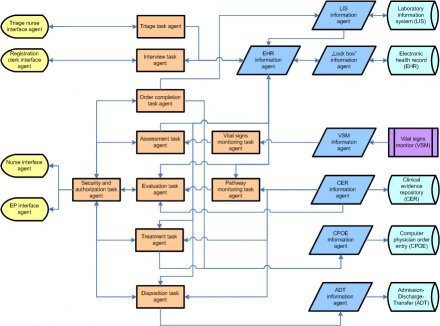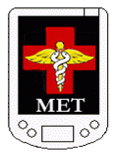Past Research
A³Support
Objective
Current phase of MET research aims to develop A³Support: a novel computing and decision support framework for clinical DSS, and to create A³Support-Asthma: a system to triage pediatric asthma exacerbations. The specific goals of our research are:
- To create the abstract A³Support ontological model for representing the clinical domain, support functionality, and system's components;
- To extend the A³Support ontological model with reasoning capabilities and to identify queries relevant for the clinical ontology, and the asthma exacerbations ontology in particular;
- To extend the A³Support ontological model so it can be effectively used for automatic modification of a system's components once the clinical problem description is revised;
- To annotate the A³Support ontological model with with access rights of different users so it becomes an effective model governing data access and it enforces security and privacy imposed by legal ramifications;
- To design a distributed, agent-based A³Support architecture where agents have necessary level of "intelligence" to provide ubiquitous triage support;
- To evaluate A³Support-Asthma during prospective trial at CHEO.
Clinical Problems
Asthma Exacerbations
Asthma exacerbations are one of most common reasons for children to be brought to the ED. Management guidelines are aimed at identifying three levels of attack severity: mild, moderate, and severe. Thus, early identification of the severity of an asthma exacerbation has implications for the child's management that includes repeated bronchodilator treatments, along with systemic corticosteroids for most patients; and additional adjuncts combined with ventilatory support for very severe cases. Patients with a mild attack are usually discharged home following a brief course of treatment (less than 4 hours) and resolution of symptoms, patients with a moderate attack receive more aggressive treatment over an extended observation in the ED (up to 12 hours), and patients with a severe attack receive maximal therapy before ultimately being transferred to an in-patient hospital bed for ongoing treatment (after about 16 hours in the ED). Predicting severity of asthma exacerbation early in ED management (at 2 hour mark) is difficult due to a limited amount of clinical information that can be used.
Architecture
During the patient management process, all members of the ED team (triage nurse, registration clerk, nurses, and EP) record patient information in the patient's chart as part of the EHR. Decisions are based on the information stored and retrieved from multiple sources, such as the EHR of prior visits, results from the laboratory information system (LIS), vital signs from VSM, and published evidence from on-line searches (e.g., PUBMED). Moreover, in order to follow the clinical pathway, caregivers interact with several internal systems to place laboratory requests and suggested treatment using the computer physician order entry (CPOE), evaluate bed availability using ADT system, and prepare disposition information using EHR. The necessity to switch between different systems combined with the requirement to constantly monitor the patient's state, introduces additional burden that may eventually lead to a critical mass problem, where the user will not be able to navigate between specific computer systems to complete routine tasks.
Thus, it is clear that in a computerized ED environment, the effective management of a patient would benefit from a comprehensive DSS accessible to all caregivers involved in the process. The design of such a clinical DSS can be addressed by a multi-agent framework that offers a single "access point" to the information and functionality comprising the various hospital systems and monitors routinely used during patient care. The framework is involves three types of collaborating agents:
- Interface agents - interacting with human users;
- Task agents - performing specific tasks;
- Information agents - providing access to heterogeneous information sources (databases, knowledge bases and external information systems).
A³Support interfaces with all clinical systems (EHR, CPOE, LIS, ADT) and monitors (VSM) that are used by the caregivers during the entire patient management process from initial triage through the disposition decision. Following the evidence-based principles, the caregivers rely not only on clinical information, but also use evidence-based medical knowledge that includes practice guidelines, clinical pathways, drug reference manuals and past cases stored in the clinical evidence repository (CER).

In A³Support all systems comprising the clinical evidence repository (ADT, CPOE, EHR, LIS and VSM) are assigned appropriate information agents that provide access to stored and monitored information. Moreover, the access to EHR is further controlled by the "lock box" task agent that filters requested and provided information according to the lock box (the limits that patients can place on the use and disclosure of their personal health information).
A³Support includes around four interface agents specific for each type of caregiver and the tasks they complete: the triage nurse interface agent for triage assessments, the registration clerk interface agent for registration interviews, the nurse interface agent for clinical assessments and completion of physician orders, and finally the EP interface agent for the EP evaluation, as well as treatment and disposition decision-making. Nurse and EP interface agents interact with the security and authorization agent that ensures that only authorized users can access the DSS and that they they use the DSS in authorized way (e.g., according to their responsibilities).
All task agents work autonomously, thus there is no need to plan their cooperation. The user of the clinical DSS plays the role of a "super-agent" that controls the management process, passes requests to specific task agents through corresponding interface agents and is presented with the results.
